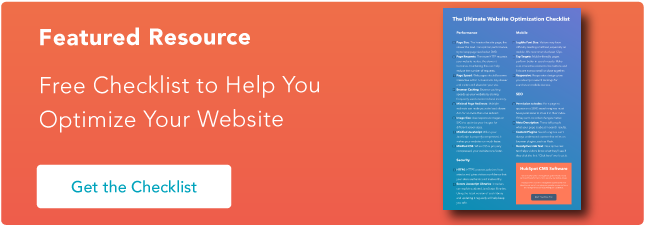Instead of worrying about the what ifs, wouldn't it be much easier to have a comprehensive website checklist to run down before every site launch? One that you could use for enterprise websites, microsites, landing pages, and everything in between?
Fortunately, we've created just that. Keep reading to learn everything you need to do before, during, and after launching a website.
What You Should Do Before Beginning Your Site Design
Whether this is your first website that is being built from scratch or you are doing a website redesign, there are a few steps that you should take before hiring a web designer or diving in yourself.
1. Analyze your previous website (if applicable).
In order to make good decisions, you must first understand where you've been. That starts with your existing website if you have one. Ask yourself:
- What is the purpose of a new design or overhaul?
- What haven't hasn't been accomplished with this existing site?
- How will a new design serve the new organization?
The answers to these questions can help you identify your gaps, which can then inform goal setting for the new site.
2. Crawl your old site (if applicable) and document its structure.
You can get an idea of your site's existing structure, pages, and assets by using a crawling tool such as Screaming Frog. This is a necessary step in creating your website development plan because you'll have a more concrete view of what pages existed before, what redirects are in place, and what the meta data currently looks like.
3. Obtain benchmark data from your previous website (if applicable), and confirm testing procedures.
Not only will you want to compare how your new site performs compared to the old, but you'll also want to continue identifying gaps that will provide data-driven insights to aid your new strategy.
Additionally, you'll want to confirm testing procedures. Soon, you'll begin testing your website to make sure all the different components are working, everything flows, and there's a system for tracking bugs and enhancements.
Use a form (like Google Forms) instead of asking people to email their thoughts so the feedback-gathering process is more streamlined. Then, put one person in charge of choosing which bugs to prioritize, and filtering all the creative feedback you receive through the form.
4. Identify your goals for the new design, how you'll achieve them, and how you'll measure success.
Once the gaps are fully fleshed out, you can begin crafting your goals for the design. You may come to conclusions such as:
- The current site is unwieldy, and we need ease of use.
- The current site no longer looks trendy, so we need a visual refresh.
- The current site doesn't perform, so we need a more SEO-friendly structure with a better UX.
Whatever your goals, you'll want to understand exactly how a new site will help you achieve them so that you can craft its implementation accordingly.
5. List out action items, roles, and responsibilities.
Make a project management checklist for the website. What content needs to be written? What calls-to-action need to be created?
Make a master list of the things you need for your website and deadlines for when they should be completed.
Then, assign each action item to an individual or team. It usually takes a lot of people to launch a website: You have marketers writing the content; designers choosing images and laying out the overall look and feel; a technical team doing all the back-end development. To ensure everyone's on the same page and there's no role confusion, you'll want to lay out a comprehensive plan for what each team or person is responsible for.
One great way to do this is by using the DARCI model, which stands for Decision Maker(s), Accountable, Responsible, Consulted, Informed. It's a powerful tool that'll help everyone understand which individual is responsible for completing which action items, which individual(s) or group(s) need to be consulted before any final decisions are made, and who needs to be consulted once a final decision has been made or an action has been taken.
6. Prepare for worst-case scenarios.
Poll everyone involved in your website launch on their concerns about what could go wrong, and then devise a few backup plans for what to do when — not if — some of these things go wrong.
7. Choose a Solid CMS.
If you've never launched a site before, the long list below might intimidate you. However, it actually shouldn't take too long to run through most of the aspects on this list — especially if you built your website with a solid CMS.
A CMS, or content management system, often allows you to design a website from a pre-created template, optimize your content for SEO, and edit content after it's published. If you've already built your website, you might have already gained experience with using a CMS.
But, if you're still building a website, one way to make going through this checklist less time consuming is by building your pages on a CMS that already does a lot of the work for you.
For example, HubSpot's Content Hub that allows you to create and edit content including landing pages and blog posts. It's features also allow you to organize your content, schedule it, track analytics, and optimize it for SEO.
Alternatively, you can also test out CMS platforms like WordPress, Wix, or even Drupal.
8. Develop a consistent brand.
Decide on a consistent brand message and tone, one that you're committed to presenting consistently across. This will make you look more legitimate, credible, and memorable.
- Understand your value proposition.
- Choose a mission statement, vision statement, and tagline that represents that value as well as your brand identity.
- Choose colors and fonts that convey that identity well.
- Decide on the type of imagery that you'll use to further convey your messaging.
9. Create your technical SEO strategy.
Take some time to ensure that your website has been given a solid foundation for SEO success. From site architecture and content hierarchy to metadata and XML sitemaps, do not leave any stone unturned.
- Perform keyword research and decide what you want to rank for.
- Create a content strategy that satisfies those keywords.
- Understand how your existing pages (if applicable) can be adjusted and which pages will need to be created new.
- Figure out which pages are no longer necessary.
- Map out where unnecessary pages can be redirected to (using a 301 redirect).
10. Strategize your conversion paths.
Once you have an understanding of the primary pages that will exist on your site, you'll need to figure out exactly what actions you want users to take and how you'll capture their information. This includes thinking through:
- What premium top-of-the-funnel offers are needed
- What bottom-of-the-funnel action will be presented on main pages
- What forms need to be created
- What landing pages and thank you pages need to be created
- How conversions will be tracked
- What actions will happen after a website visitor converts (email responder, etc.)
11. Set up analytics software.
- Choose which analytics platforms you will be using on the new site.
- Decide if any previous Analytics tracking scripts will be used or if new accounts/scripts are needed.
- Set up new accounts (if applicable).
12. Set a launch date.
Once you have an idea of what needs to get done before the launch, pick a launch date. Give yourself at least a month. Most agencies plan for two-to-three months of research, design, and development.
What to Check Once You've Built Your Site
Once you've chosen a CMS and built a site that you're ready to launch, here's a list of 80 things to check before, during, and after going live. Feel free to copy, edit, and make your own based on the software you're using to launch and host your website.
Don't have time to check all 80? Here's a list of the most important highlights from each section:
Website Launch Checklist
- Make sure text is accurate and error free.
- Replace all placeholder images with final images and designs.
- Ensure copy aligns with the new brand.
- Check that all styling preferences have been implemented.
- Ensure your design is aesthetically pleasing.
- Ensure that rights to images, fonts, and other content have been properly licensed or cited.
- Test the site for User Experience (UX).
- Check that the conversion paths have been implemented properly.
- Create your site backup strategy.
- Store passwords and credentials in a secure place.
- Audit the technical SEO implementation for errors.
- Test the site for user experience again.
- Test your conversion path's functionality.
- Check that integrations with third-party tools are running smoothly.
- Make a copy of the final website for backup purposes.
- Ensure that backups are running properly.
- Make sure your site is secure.
- Comply with all applicable laws.
- Crawl the site to ensure no errors happened on launch.
- Check the technical SEO components for errors.
- Optimize your metadata.
- Set up analytics.
- Build anticipation with teasers before the site is live.
- Create a social media strategy for the announcement.
- Identify exciting ways to promote engagement for the new site.
- Send an email to your existing database.
- Continue to promote the launch for a month.
We've grouped items based on pre-launch and post-launch, making sure to touch on page content, design, functionality, SEO, branding, analytics, security, and compliance. Keep on reading to make sure you don't forget a thing before your next launch.
Website Pre-Launch Checklist
Before you launch, it's important to review all of the content on your website with a fine-tooth comb. Of course, that means page content, but don't forget about your premium content, too. From data-driven content and downloadable documents to rich media such as videos and images, you want to make sure everything is in place, working properly, and looking beautiful.
It's important to note — you'll want to set up a staging site to prepare your new website before going live. Staging sites are exact copies of your website on a private server that are used to prepare and proof content and code changes before they go live. The staging site is a place to edit and play around with updates in an environment that's almost identical to the one that will be live. This is so you don't have to worry about crashing your site or screwing something up when you make a change.
Later, you'll sync content and templates between the staging environment and your live website via your content management system (CMS). If you're a HubSpot customer with the website platform, you'll find there's a staging environment built right into the software. It allows you to generate a preview URL of the entire site, so you can click around and test things in context.
1. Make sure text is accurate and error-free.
- Site content has been proofread for spelling and grammar.
- Company contact details are accurate throughout the website.
- Generic content, such as lorem ipsum, has been properly removed and replaced.
- All premium content, such as case studies, ebooks, and whitepapers, have been proofread. Spelling and grammar are correct.
- Copyright date (perhaps in the footer) includes the current year.
2. Replace all placeholder images with final images and designs.
On occasion, a website designer may use a placeholder image if they didn't have the correct asset at the time of the page's creation. It's up to you to make sure each page is picture-perfect.
3. Ensure copy aligns with the new brand.
- The text has been copy-edited to ensure consistent brand voice and style.
- All company tag lines and mission statements are up-to-date.
4. Check that all styling preferences have been implemented.
- Paragraphs, headers, lists, and other formatting are correct.
- Brand colors have been implemented correctly, including link and button colors.
5. Ensure your design is aesthetically pleasing.
- Scripts are optimized across web pages.
- Images are optimized across web pages.
- CSS is optimized across web pages.
6. Ensure that rights to images, fonts, and other content have been properly licensed or cited.
Even if you outsourced the design to a web designer/developer, the responsibility falls on you to ensure there are no copyright licensing issues. Otherwise, you could end up with a hefty infringement settlement on your hands.
7. Test the site for User Experience (UX).
- Website pages are compatible across browsers.
- Website pages are compatible across devices.
- Images, videos, and audio files are in the correct places, formatted and working on all devices.
- All premium content, such as case studies, ebooks, and whitepapers, are stored in their proper libraries/databases and work properly.
- Internal links across web pages are working properly.
- Social media share icons are associated with the correct accounts.
- Company logo is linked to the homepage.
8. Check that the conversion paths have been implemented properly.
- All necessary forms are present.
- Landing pages and thank you pages have been implemented.
- The correct buttons and calls-to-action (CTAs) are present in the proper locations.
- Everything is linked together appropriately.
9. Create your site backup strategy.
You can prevent loss of data and protect against malware and other damages by properly setting up site security and regular website backups. Check that:
- Backup schedule has been created.
- Backup location has been identified.
- A plan for implementation is set to be put in motion after launch.
10. Store passwords and credentials in a secure place.
Many individuals have likely been involved in the website launch up until this point, so ensure that passwords are reset when the time comes and proper password etiquette is followed.
11. Audit the technical SEO implementation for errors.
- Pages have unique page titles.
- Pages have unique meta descriptions.
- Each page has a specific purpose, and pages meant to rank organically are optimized around a single keyword or set of keywords.
12. Conduct a stress test.
In a typical website redesign, it may not be 100% necessary to do a stress test because the traffic spike may not overrun your server's capacity. But a stress test (also called a load test) is a must for any company that plans for a large influx of visitors during specific times — such as the holidays or after a major press event. It'll help you figure out how much simultaneous traffic your website can handle by simulating up to tens of thousands of simultaneous virtual users from different locations around the world.
While stress tests simulate virtual users, the test won't be totally replicating a real-life scenario — so you'll want to find a test that brings you as close to reality as possible. Ask a developer which load tests they recommend. Here at HubSpot, many of our developers use JMeter by Apache, but this is a pretty technical tool that's not ideal for someone who's new to the concept.
Be sure to notify your host or provider that you want to perform a stress test before you actually do one. Otherwise, your test might look like a DDoS (Distributed Denial of Service) attack on your provider. Many providers (including HubSpot) consider an unauthorized load test a violation of terms of service.
User experience is a key aspect of how they view your company, so testing your website before it goes live will bring more confidence that visitors will not be immediately displeased with your offerings. When working with a web development agency, they will ensure that stress testing and other quality assurance measures are implemented to optimize the performance and user experience of your website.
Website Post-Launch Checklist
Let's say you've done it. The button has been pushed, the domain is pointing to the new site, and you're about ready to tell the world...
But wait just one second because you still have things to check for now that your site is officially live.
13. Test the site for user experience again.
Just in case there was an issue with the implementation, you'll want to ensure the experience is consistent with what you reviewed before it went live.
- Ensure your design is rendering as you expected it to across browsers.
- Ensure your design is rendering as you expected it to across devices.
- Ensure CSS/HTML is properly validated.
- CSS styling is rendering properly.
- Favicon is in place and rendering properly.
- Internal links across web pages are working properly.
- External links across web pages are working properly, and open in a new tab.
- Social media share icons are working properly.
- Feeds are working properly (RSS, news, social media).
- Company logo is linked to the homepage.
- 404 Redirect pages are in place (page-not-found.aspx).
14. Test your conversion path's functionality.
Take some time to test and validate all of the different features on your website. Lead generation forms, CRM integration, and any other technology should work flawlessly across your website.
- Forms are submitting data properly.
- Thank you message or page displays after form is submitted.
- Form data is being emailed to a recipient and/or stored in a company database.
- Auto-responders are working properly (if applicable).
15. Check that integrations with third-party tools are running smoothly.
Integrations such as your CRM, e-commerce software, and/or marketing platform link to your site and help you run your business. If there is a potential issue that can cause data loss, you don't want to find out way after the fact.
16. Make a copy of the final website for backup purposes.
Now that everything is in place and finalized, you want to have a pristine copy of it should you experience data corruption or loss.
17. Ensure that backups are running properly.
Now is the time to check the implementation of your backup strategy. Check that ongoing copies of the website are being created and stored on a regular basis.
18. Make sure your site is secure.
- 24/7 monitoring scripts are installed.
- There's a plan in place for updating plugins (if applicable).
- Ensure that all applicable parties are aware of your organization's password etiquette policies.
- Purchase an SSL certificate if need-be. An SSL certificate takes up to two weeks to purchase and set up, so ensure you have it prior to launch. (An SSL certificate will ensure your website is encrypted so hackers can't intercept any of your data. Not only will this put your website visitors at ease, but it'll also boost your website's SEO since SSL is now part of Google's search ranking algorithm.)
19. Comply with all applicable laws.
Make sure your website complies with any applicable laws and regulations. Internet law can be sticky, and each industry has its own set of rules to follow. So it's best to consult with your legal counsel to make sure you aren't missing anything — this post is not legal guidance. Here are a few you might need to know about:
- Web pages offer accessibility for users with disabilities (WAI-ARIA).
- Web pages announce if the website uses cookies (required in some countries).
- Website is compliant with usage rights for purchased or borrowed code, images, and fonts.
- Terms and privacy policies are visible to website visitors.
- Website is PCI compliant (if you're storing and processing credit cards).
20. Crawl the site to ensure no errors happened on launch.
Compare the crawl to the previous crawl and see if you find any inconsistencies that were not intentional. You'll also want to ensure that all pages have the proper search engine indexing settings.
Additionally, you'll want to check for formatting consistency. Sometimes, font codes get dropped into a page accidentally, so you'll want to scour your site for any of these weird formatting errors. Make sure all your formatting is consistent and there are no weird blips in your copy.
21. Check the technical SEO components for errors.
- Page titles, meta descriptions, and URLs are all present and match the original technical SEO strategy.
- Load time for site pages is optimized.
- A dynamic XML sitemap has been created.
- The XML sitemap has been submitted to search engines.
- Page URLs consistently reflect site information architecture.
- 301 redirects are in place for all old URLs (redirecting old to new pages).
- rel="nofollow" tags are in place on applicable links and pages.
- Images on the website are properly compressed (which helps with load time).
22. Optimize your metadata.
- Metadata is properly in place for any content in an RSS feed.
- Metadata is properly in place for any social media sharing content.
- Spelling and grammar are correct in all metadata.
- Alt tags have been added to every image.
23. Set up analytics.
Make sure your website is set up to capture web data and analytics. This valuable information will allow you to continually improve your website going forward, so you don't want to forget this stuff.
- Your website analytics codes and tracking scripts have been inserted on website.
- Relevant IP addresses have been excluded from analytics tracking.
- Funnels and goals have been properly created in your analytics software (if applicable).
- Google Webmaster and Google Analytics accounts have been properly synced.
- Google Ads accounts have been properly synced (if applicable).
24. Start a post-launch enhancement list.
The website you launch should be functional, well-designed, and well-positioned. But it probably won't be everything you hoped and dreamed on the first go — and you certainly don't want to spend months of effort designing a site that people may not react well to. What if your client doesn't like it? What if conversion rates plummet? That could add up to lost money and effort.
Instead, it's best to publish a solid website, and then test and build on top of it — a website creation approach known as growth-driven design. Create a document that lists out all the things you can't get done for the launch itself but want to add in the future, and add features and elements to it as you discover more about how users interact with the site. This you can do by using one of these user testing tools.
How Do You Announce a New Website Launch?
This (hopefully) wasn't a vanity project; you did all of this work so far for the benefit of your website visitors, prospects, and existing customers. Your next step is to tell the world about your new site design. Here's how:
25. Build anticipation with teasers before the site is live.
A launch of a new product, a launch of a new movie, and — yes — a new site launch all require marketing before the actual release. Think of the last movie you watched in the theater. Did you see the trailer before you decided to buy those movie tickets and popcorn?
Teasers for your website launch can only help to build anticipation and get users wondering what the new experience will be like. This can build buzz and interest once you finally break the news.
26. Create a social media strategy for the announcement.
Decide what channels you want to promote the news on, how you will make the announcement, and how long the promotion will last.
As you craft your messaging, remember to focus on new features and how they benefit your audience.
27. Identify exciting ways to promote engagement for the new site.
For users who aren't as involved in your brand, a new site launch might not seem like a big deal. Your goal, then, is to make it one. Provide an exclusive offer for the first users who visit the site. Or, create a contest that promotes engaging with the site's new features. Whatever you choose, make sure you make it fun and interesting.
28. Send an email to your existing database.
You may want to give existing leads and customers a head's up about the new design, especially if it will cause any confusion when they next visit. You can break the news as a matter of courtesy but also sneak in ways to underscore the value you're providing.
You can also alert all stakeholders of the redesign and ask them to spread the word of the new website.
29. Continue to promote the launch for a month.
Just because you post about your new website once on social media does not mean that your audience will drop everything to visit the site in droves. Make your launch a big deal, and keep the new functionality top of mind so that your audience is prompted multiple times to check it out.
(Once your website is launched, remember to resubmit your XML sitemap to all major search engines once you're done, too.)
Resources for Launching Your First Website
Launching a new website can be a tedious task, but you can alleviate some of the stress by using this comprehensive website launch checklist.
If you're just getting started on your first website, here are a few tools that can help you streamline your process
- CMS: As mentioned above, a CMS can help you design your website, optimize and publish content, and track your analytics once it's launched. If you're looking to test out a few CMS options, start by checking out our 14-day free CMS trial.
- Blogging Guides: If you're interested in using your website to publish a blog that could help you boost brand awareness, it can be helpful to start brainstorming topics. Here's a great guide to how to be a better blogger with tips from our team.
- Landing Page Templates: A landing page is a great way to highlight a product or resource that your brand is offering. It's important to know what elements lead to a landing page that will convert. Here's a guide with examples. Additionally, when using a CMS like HubSpot's, you can create landing pages from pre-designed templates.
Editor's Note: This blog post was originally published in August 2014, but was updated for comprehensiveness and freshness in June 2021.


.png)


![What makes a good website? Here are 16 things I look at [new data]](https://53.fs1.hubspotusercontent-na1.net/hubfs/53/what-makes-a-good-website-1-20250527-1287063.webp)







